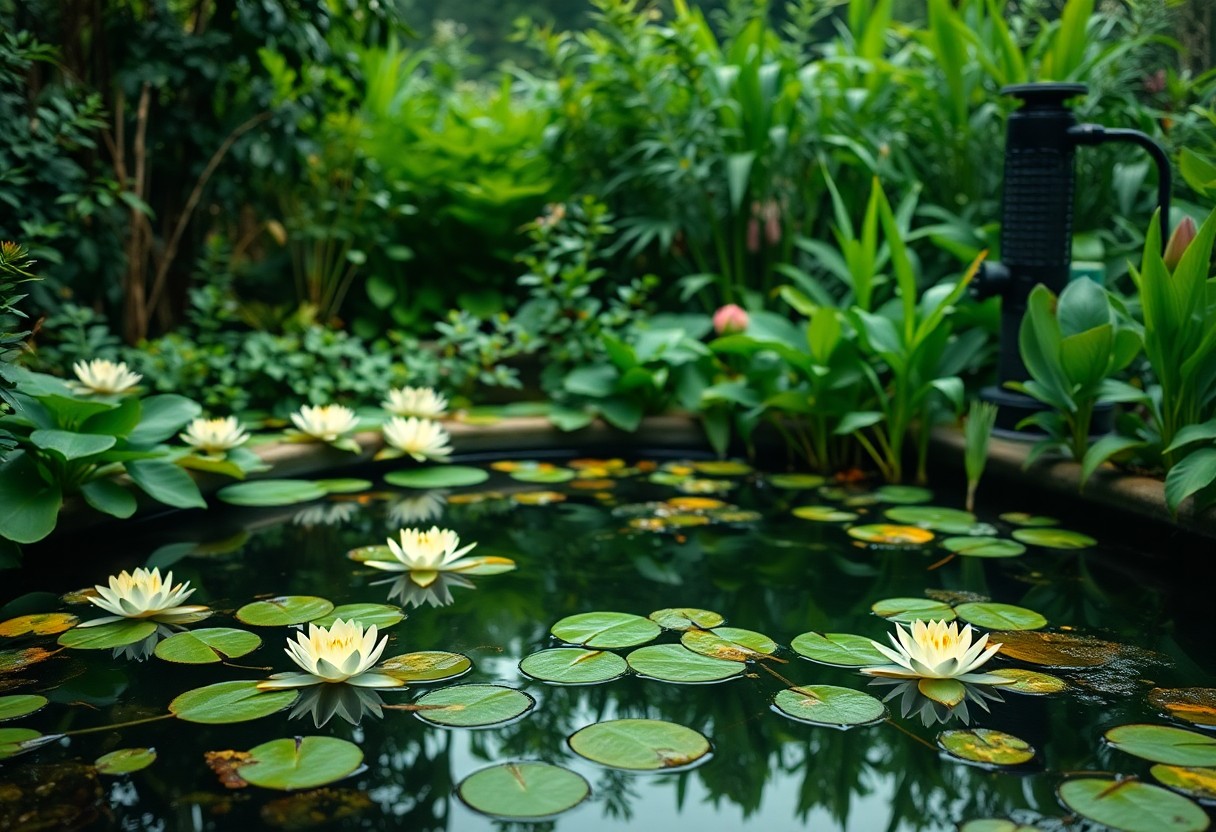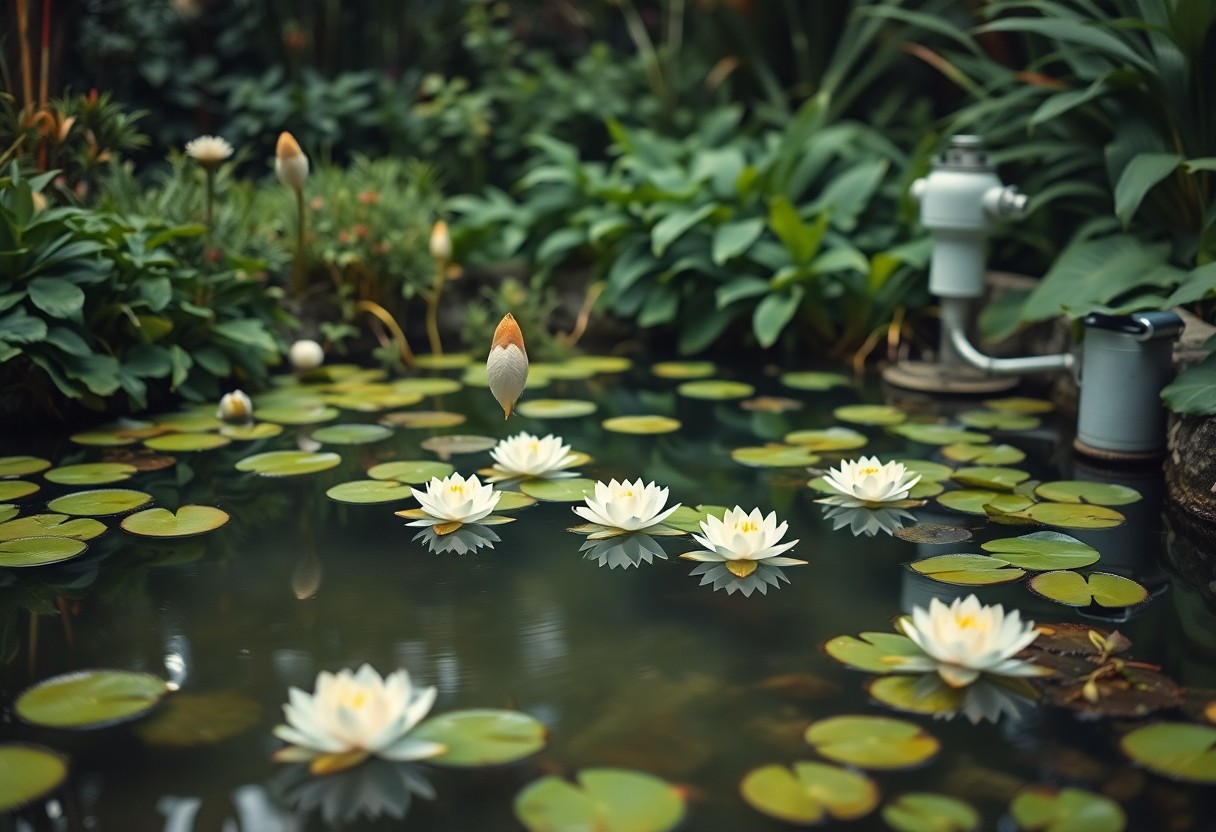This guide will help you prevent algae overgrowth in your pond, ensuring a healthy environment for fish and plants. When left unchecked, algae can cause harmful conditions that affect water quality and aquatic life. By implementing effective strategies like managing sunlight, minimizing nutrient input, and introducing beneficial additions such as plants and bacteria, you can maintain a balanced ecosystem. With a few simple steps, you’ll promote a vibrant, clear pond that enhances the beauty of your outdoor space.
Table of Contents
Key Takeaways:
- Maintain proper nutrient levels in the water by minimizing excess fertilizers or runoff from surrounding areas.
- Incorporate aquatic plants that compete with algae for resources, thereby reducing growth potential.
- Implement regular maintenance such as removing debris and organic matter that can contribute to nutrient buildup.
- Monitor and control sunlight exposure; consider using shade-providing plants or structures to limit direct sunlight on the water surface.
- Ensure proper water circulation to prevent stagnation, which can promote algae development.
Understanding Pond Algae
The presence of algae in your pond is natural. However, when it becomes excessive, it can lead to serious water quality issues. Algae produce oxygen during the day but consume it at night, which can deplete the oxygen in the water and harm aquatic life. To maintain a healthy ecosystem, understanding the different types of algae and their growth patterns is imperative.
Types of Common Pond Algae
- Green algae – Often forms a green film on the water surface.
- Blue-green algae – Can produce toxins harmful to animals and humans.
- Filamentous algae – Appears as stringy mats and can entangle plants.
- Chara – A type of green algae resembling submerged plants.
- Duckweed – A floating plant that can cover the surface area quickly.
Assume that understanding these different types allows you to identify and manage algae efficiently.
Causes of Algae Overgrowth
Even the slightest imbalance in your pond’s ecosystem can lead to algae overgrowth. Factors such as excess nutrients, stagnant water, and high light exposure can create a perfect environment for algae to thrive.
For instance, high levels of nutrients like nitrogen and phosphorus—often from fertilizers, decaying plant matter, and fish waste—can encourage rapid algae growth. Stagnant water, which lacks proper circulation, also contributes to this issue by creating a warm, nutrient-rich habitat. Additionally, areas with plenty of sunlight can lead to increased photosynthesis, resulting in an algae bloom. By addressing these sources, you can maintain a balanced ecosystem in your pond.
Environmental Factors
You need to consider several environmental factors that can contribute to algae overgrowth in your pond. Effective management of these elements can help maintain a balanced ecosystem:
- Sunlight exposure
- Water temperature
- Water quality
Thou must be proactive in addressing these factors to promote a healthy pond atmosphere.
Sunlight Exposure
Even minimal amounts of sunlight exposure can significantly impact algae growth in your pond. While some light is beneficial for aquatic plants, excessive sunlight can lead to nutrient imbalance and encourage algae blooms.
Water Temperature and Quality
Sunlight and temperature play a vital role in your pond’s ecosystem. For your reference, here’s a breakdown:
Water Parameters
| Parameter | Ideal Range |
|---|---|
| Temperature | 65°F – 75°F |
| pH Level | 6.5 – 8.5 |
| Dissolved Oxygen | 5mg/L or higher |
Environmental conditions such as high temperatures can decrease your pond’s dissolved oxygen levels, which is detrimental to fish and aquatic life. Frequent testing and adjustment of water quality parameters will ensure a stable environment and minimize algae growth.

Prevention Methods
Unlike waiting for algae to bloom in your pond, proactive prevention methods are crucial for maintaining a balanced and healthy ecosystem. Regular maintenance, such as controlling nutrient levels and ensuring proper water circulation, can significantly reduce the likelihood of overgrowth. Additionally, using physical barriers and encouraging natural predators can help keep algae levels in check, creating a harmonious environment for your pond’s plants and animals.
Natural Solutions
While introducing aquatic plants is a wonderful way to combat algae naturally, you can also consider adding beneficial bacteria to your pond. These organisms consume excess nutrients and help keep algae at bay. You can also install a UV clarifier, which can improve water clarity by targeting the smallest algae particles, adding biological balance without harsh chemicals.
Chemical Treatments
An effective option when it comes to controlling algae is chemical treatments. These products can help manage problematic blooms and restore the balance in your pond when natural methods are insufficient. However, it’s important to choose algae control solutions carefully, as some can have adverse effects on aquatic life.
Plus, when considering chemical treatments, you should ensure that you select environmentally friendly options, as harsh chemicals can harm fish and other wildlife. Always follow label instructions for safe application, and never apply treatments during periods of high temperatures or low oxygen levels, which can increase the risk of harming your pond’s ecosystem. Regularly monitoring your pond is also crucial to evaluate the effects of any treatment and to achieve long-term control of algae growth.
Pond Maintenance Tips
Many pond owners overlook the importance of regular maintenance, which can lead to algae overgrowth. To keep your pond healthy, consider implementing the following tips:
- Perform regular water changes
- Maintain proper plant levels to provide shade
- Use beneficial bacteria to balance nutrients
- Avoid overfeeding fish to reduce waste
- Control sunlight exposure to limit algae growth
Recognizing the signs of algae issues early on can help you take immediate action. For more information, check out this discussion on Algae control in man-made ponds (non-aerated).
Regular Cleaning Practices
For a clean and healthy pond, regularly remove debris such as leaves and excess aquatic plants. This prevents nutrient buildup, which contributes to algae blooms. Ensure you check and clean your pond filter frequently to maintain water clarity and quality.
Water Testing Routines
On a routine basis, you should test your pond’s water for parameters like pH, ammonia, and nitrate levels. This will help you determine if your pond is conducive to algae growth and if any adjustments are necessary.
Cleaning your pond is not just about aesthetics; it plays a vital role in the overall health of your aquatic ecosystem. Regularly monitor for harmful bacteria and test the water chemistry to ensure it remains within safe levels. Utilize test kits that measure toxins and nutrient levels to prevent unexpected algae outbreaks and keep your pond’s environment stable.
Balancing Pond Ecosystem
Now, maintaining a balanced pond ecosystem is necessary for preventing algae overgrowth. You need to create a harmonious environment where each element—plants, fish, and water quality—works together. This balance will help stabilize nutrient levels and reduce the chances of excessive algae growth, ensuring your pond remains vibrant and healthy.
Beneficial Plants
Beneficial plants play a vital role in your pond’s ecosystem. By introducing native aquatic plants, you can help absorb excess nutrients that fuel algae growth. These plants also provide shade, habitat, and oxygen for aquatic life, creating a balanced environment that supports your pond’s health.
Fish Population Management
Little fish population management is necessary to maintain the right balance in your pond. By carefully regulating the number and species of fish, you can control algae levels effectively. Fish like goldfish and koi can help reduce unwanted algae, but overstocking can lead to increased waste and nutrient loads, promoting algae growth.
Plus, managing your pond’s fish population helps prevent overcrowding and maintains a healthy balance of nutrients. By monitoring food intake, pond size, and fish types, you can create a thriving aquatic environment while keeping algae growth at bay. You might consider collaborating with a local aquaculture specialist for effective fish selection and stocking rates, so your pond remains balanced and vibrant.
Seasonal Care
All pond owners should be aware that proper seasonal care is crucial for preventing algae overgrowth. Implementing effective maintenance strategies during different seasons can significantly enhance the health of your pond ecosystem. For more details on Coping with algae in ponds, follow expert recommendations to help keep your pond thriving.
Spring and Summer Maintenance
On warm months, actively manage sunlight exposure and nutrient levels in your pond. Regularly remove debris, reduce fertilization runoff, and introduce aquatic plants to compete with algae for nutrients. Installing a pond aerator can also help by increasing oxygen levels, which deters algae growth.
Fall and Winter Preparation
With cooler weather approaching, concentrate on preparing your pond for harsher conditions. Start by cleaning the pond thoroughly, removing excess leaves and organic matter that could decay and elevate nutrient levels, which contributes to algae growth in spring.
It is important to ensure that your pond is ready for winter. Cleaning the pond of any debris and reducing nutrient buildup will minimize the risk of algae bloom come spring. Consider adding bacteria treatments designed to break down organic matter as this helps maintain a balanced ecosystem. Additionally, aeration can prevent ice from forming on the entire surface, which promotes a healthier environment for aquatic life during cold months. By taking these steps, you create a stable foundation for your pond’s well-being.
Final Words
Upon reflecting, it becomes clear that preventing algae overgrowth in your pond requires a combination of strategies. You should maintain a balanced ecosystem by managing nutrient levels, ensuring proper filtration, and incorporating aquatic plants. Regular maintenance, like cleaning debris and monitoring water conditions, can further support a healthy aquatic environment. By taking these proactive measures, you can enjoy a vibrant and thriving pond, free from the troubles of excessive algae growth.
FAQ
Q: What are the main causes of algae overgrowth in ponds?
A: Algae overgrowth in ponds can stem from various factors including excessive nutrient input from fertilizers, lawn runoff, decaying organic matter, and high levels of sunlight. Nutrient-rich waters, particularly those containing high levels of nitrogen and phosphorus, are particularly prone to algae blooms. Minimizing these inputs is key to maintaining a balanced pond ecosystem.
Q: How can I control nutrient levels in my pond?
A: Controlling nutrient levels can be achieved through several strategies. Firstly, limit the use of fertilizers in the surrounding area and opt for natural alternatives when possible. Installing buffer zones with native plants along the edges of your pond can help absorb excess nutrients. Additionally, regular maintenance like removing leaves and organic debris can prevent the decomposition process that adds nutrients to the water.
Q: What role do plants play in preventing algae growth?
A: Aquatic plants are imperative in maintaining a healthy pond ecosystem. They compete with algae for nutrients and sunlight, thereby helping to limit algae growth. Consider introducing submerged, floating, and emergent plants to your pond. These plants not only shade the water but also promote a balanced habitat for fish and other wildlife, ultimately leading to healthier water conditions.
Q: Is it effective to use algaecides in ponds?
A: While algaecides can provide a temporary solution to algae growth, they often do not address the underlying issues causing the overgrowth. Over-reliance on chemical treatments can disrupt the pond’s ecosystem and harm beneficial organisms. It is advisable to use algaecides sparingly and in conjunction with other preventive measures such as improving aeration and maintaining nutrient balance.
Q: How can aeration help in managing algae in my pond?
A: Aeration plays a significant role in managing pond health and can effectively reduce algae growth. By increasing oxygen levels in the water, aeration promotes the growth of aerobic bacteria that can break down organic matter. This not only helps clarify the water but also reduces nutrient levels, making it less conducive for algae to thrive. Consider using aeration devices like fountains or aerators to keep your pond oxygen-rich.

